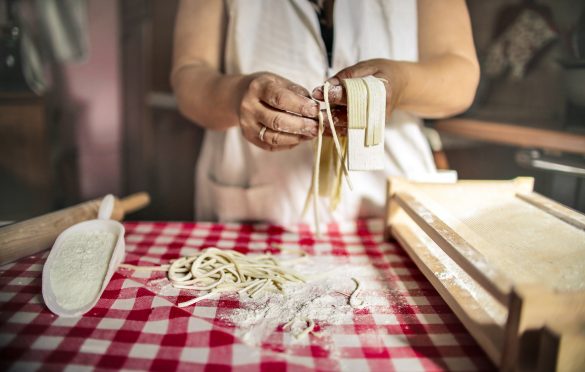I spend my days hustling between clients’ homes and countertop slab yards. I start the day in my own kitchen, re-designing it in my head as I wonder what I’ll make for dinner when my hungry mob gets home. My real and imagined kitchen, as well as my clients’, swirl in my brain, a sea of knobs, appliances, door styles, paint chips, tile samples. What’s actually for dinner in my real kitchen usually comes back to mind as a relative emergency at about 430 p.m., if the slow cooker doesn’t intervene.
So I stopped in my tracks, hearing the proverbial record scratch, when I first discovered an Instagram account known as Pasta Grannies. This account features women at work, making pasta dishes primarily, in their kitchens in Italy.
The lives of these women seem wildly antithetical to my own life and the lives of many American women. For starters they seem unconcerned with the camera. Their focus is clear — it’s the pasta. But they live out their femininity in a uniquely beautiful way, in their making of their food and their service to, presumably, their families (or whoever else is lucky enough to eat at their tables.)
The work itself is quite mesmerizing and un-narrated, so we can imagine we are there with them, watching. Their hands create with a deep and abiding wisdom, making both familiar and foreign shapes in machine-like fashion. Their spaces are no less captivating — they are small, sometimes cramped, often simple, each with layers of patina that comes from heavy duty daily use.
While often in America we are chiefly concerned with kitchens that “wear well” and remain pristine, the kitchens for these women are almost irrelevant. They are making nothing short of a sumptuous magic in spaces unthinkable to those of us who live in the land of big white open kitchens (whether owned or desired). Yet in these often humble work spaces, there is an unspeakable, unshakable faith of sorts, on display in these women. Faith and profound ownership in their art and their work, in the food, in their womanhood.
And so it begs the question, what is the big white open kitchen for, and who told us we need it so badly? My own Italian grandmother made magic in a cramped, poorly-lit kitchen in Colonia, New Jersey. I can’t cook a tenth as well as she did, and yet I’m convinced I need something much bigger and better. Part of this is perhaps generational progress, part is what has become a real estate-driven obligation, part is seeing big white open kitchens everywhere we look.
We see, ad nauseam: expansive light-filled workspaces, restaurant-caliber appliances, gleaming surfaces, gorgeous decorative details. And we’re told that even if we don’t cook, these kitchens have great value for the value of our homes. This may remain true, may even be what we want, but let’s be honest — this desire often comes from more than a pure desire to cook.
Naturally, the Pasta Grannies are somewhat of a romantic ideal, and while it’s perfectly fine to long for that, it’s also healthy to acknowledge generational and geographical differences among others. There are some benefits to the big American kitchen, too — they have become workhorses in other ways. They allow us to cook, clean, entertain, manage homework, serve, and pay bills at the same time. Furthermore, we no longer want to leave the cook alone in her work, it has become a communal space and a way to be life giving in other ways. Whether “big time cooking” happens or not, the kitchen is the heart of the home.
But seeing the joy, the love, and the tradition in the honorable work at the hands of the Pasta Grannies has made me ask myself: are we happier as a result of bigger kitchens with far less time spent cooking?
The example set by the Pasta Grannies is to me an invitation to re-evaluate what we’re sold as ideals with respect to the home, and to consider the focus and the goals of our renovations and dreams of them.
It’s worth thinking about what we really crave from the time spent in our homes — not just the spaces themselves. And I can’t help but ask, what will happen when the grannies are gone? Who will look to the food and her work before looking into the camera? Who will focus on her craft instead of being worried about how she’s aged? Who will serve in her handiwork endlessly, instead of renovating or longing to renovate the space where it actually happens? Who will say “I will cook” to the question of how a day is spent?
I may have more questions than answers, but watching the Pasta Grannies has encouraged me to consider my own dreams for my kitchen, my day, and even my life going forward, in a new light. Whether we cook or not, the love, service, connection and time spent working within the walls of our homes will always trump the knobs, slabs, hardware and appliances, and I’m thankful for the Pasta Grannies who remind us of this daily from their remarkable spaces across the world.
